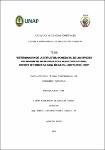Determinación de la estructura horizontal de las especies del bosque de colina baja de la CC.NN. Flor de coco, distrito de Torres Causana Río Napo – Loreto Perú. 2023
Abstract
The research work was carried out in the low hill forest of the CC.NN. Flor de Coco del, Torres Causana district Napo River – Loreto Peru. A total of 2535 trees were recorded, 28 commercial forest species and 12 botanical families, where the families Fabaceae and Myristicaceae contain the highest number of species (seven and five species respectively), otherwise the families that contain the lowest number of species are Simaroubaceae, Sapotaceae, Vochysiaceae, Calophyllaceae, Lecythidaceae and Caryocaceae (one species each). The total volumes found are 16063.154 m3 for the entire area (2893.2 Ha). Tornillo (4162.836 m3) and Lupuna (2883.194 m3), contain the highest volume values; On the contrary, Huayruro (25,783 m3), Zapotillo (20,859 m3) and Añuje Rumo (17,402 m3) have a lower volume. It was determined that the importance value index (IVI) was: The Capinurí species (196.51%) is the most ecologically important in the low hill forest of the CC.NN. Flor de Coco, district of Torres Causana Napo River, which make up a total of 196.51% of participation in the structure of this forest. Furthermore, it can be stated that two species report little participation with less than 21% of IVI, which are represented by Lupuna (15.81%), and Quinilla (4.72%), which together add up to 20.53% respectively. It was determined that there is a difference in the horizontal structure of the commercial species of the low hill forest of the CC.NN. Flor de Coco, Torres Causana district Napo River – Loreto – Peru. El trabajo de investigación se realizó en el bosque de colina baja de la CC.NN. Flor de Coco del, distrito de Torres Causana río Napo– Loreto Perú. Se registraron en total 2535 árboles, 28 especies forestales comerciales y 12 familias botánicas, donde las familias Fabaceae y Myristicaceae contienen el mayor número de especies (siete y cinco especies respectivamente), por lo contrario, las familias que contienen el menor número de especies son Simaroubaceae, Sapotaceae, Vochysiaceae, Calophyllaceae, Lecythidaceae y Caryocaceae (una especie c/u). Los volúmenes totales encontrados son 16063,154 m3 para toda el área (2893,2 Ha). Tornillo (4162,836 m3) y Lupuna (2883,194 m3), contienen los más altos valores de volumen; por el contrario, Huayruro (25,783 m3), Zapotillo (20,859 m3) y Añuje Rumo (17,402 m3) presentan menor volumen. Se determinó que el índice de valor de importancia (IVI) fue: Las especies Tornillo (49,90%), Cumala (32,50%), Aguanillo (32,42%) y Lupuna (27.42%), son las más importantes ecológicamente en el bosque de colina baja de la CC.NN. flor de coco, distrito de torres causana río napo – Loreto – Perú, que hacen en total 142,59% de participación en la estructura de este bosque. Además, se puede afirmar que dos especies reportan poca participación con menos del 02% de IVI las cuales están representadas por Huayruro (0,72%), Añuje rumo (0,50%) y Zapotillo (0,35%), que juntas suman 01,56% respectivamente. Se determino que sí existe diferencia de la estructura horizontal de las especies comerciales del bosque de colina baja de la CC.NN. Flor de Coco, distrito de Torres Causana río Napo – Loreto – Perú.
Collections
- Tesis [526]


